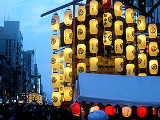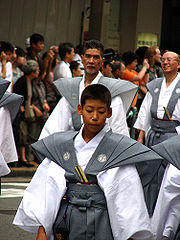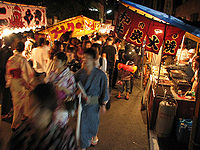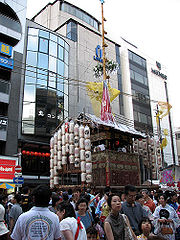
Gion Matsuri
Encyclopedia
The takes place annually in Kyoto
and is one of the most famous festivals in Japan
. It spans the entire month of July and is crowned by a parade
, the on July 17. It takes its name from Kyoto's Gion
district.
 Kyoto's downtown area is reserved for pedestrian traffic on the three nights leading up to the massive parade. These nights are known as yoiyama (宵山) on July 16, yoiyoiyama (宵々山) on July 15, and yoiyoiyoiyama (宵々々山) on July 14. The streets are lined with night stalls selling food such as yakitori
Kyoto's downtown area is reserved for pedestrian traffic on the three nights leading up to the massive parade. These nights are known as yoiyama (宵山) on July 16, yoiyoiyama (宵々山) on July 15, and yoiyoiyoiyama (宵々々山) on July 14. The streets are lined with night stalls selling food such as yakitori
(barbecued chicken skewers), taiyaki
, takoyaki
, okonomiyaki
, traditional Japanese sweets, and many other culinary delights. Many girls dressed in yukata
(summer kimono
) walk around the area, carrying with them traditional purses and paper fans.
During the yoiyama evenings leading up to the parade, some private houses in the old kimono
merchant district open their entryways to the public, exhibiting valuable family heirlooms, in a custom known as the Byōbu Matsuri, or Folding Screen Festival. This is a precious opportunity to visit and observe traditional Japanese residences of Kyoto.

 This festival originated as part of a purification ritual (goryo-e) to appease the gods thought to cause fire, floods and earthquakes. In 869, the people were suffering from plague and pestilence which was attributed to the rampaging deity . Emperor Seiwa
This festival originated as part of a purification ritual (goryo-e) to appease the gods thought to cause fire, floods and earthquakes. In 869, the people were suffering from plague and pestilence which was attributed to the rampaging deity . Emperor Seiwa
ordered that the people pray to the god of the Yasaka Shrine
, Susanoo-no-mikoto
. Sixty-six stylized and decorated halberd
s, one for each province in old Japan, were prepared and erected at Shinsen-en, a garden, along with the portable shrines (mikoshi
) from Yasaka Shrine.
This practice was repeated wherever an outbreak occurred. In 970, it was decreed an annual event and has since seldom been broken. Over time the increasingly powerful and influential merchant class made the festival more elaborate and, by the Edo period
(1603–1868), used the parade to brandish their wealth.
In 1533, the Ashikaga shogunate
halted all religious events, but the people protested, stating that they could do without the rituals, but not the procession. This marks the progression into the festival's current form. Smaller floats that were lost or damaged over the centuries have been restored, and the weavers of the Nishijin area offer new tapestries to replace destroyed ones. When not in use, the floats and regalia are kept in special storehouses throughout the central merchant district of Kyoto in the care of the local people.
This festival also serves as an important setting in Yasunari Kawabata's
novel, The Old Capital
which he describes it along with the Festival of the Ages
and the Aoi Festival
as "the 'three great festivals' of the old capital."
 Following is a list of selected events of Gion Matsuri every year.
Following is a list of selected events of Gion Matsuri every year.
 The floats in the Yoiyama Parade are divided into two groups, Hoko and Yama, and are collectively called Yamaboko (or Yamahoko). There are 9 of the larger Hoko (long pole or halberd) which represent the 66 spears used in the original purification ritual, and 23 of the smaller Yama which carry life-size figures of famous and important people. All the floats are decorated with beautiful tapestries both from Nishijin (the finest in all of Japan) and imported from all over the world. In addition to the art, there are many traditional musicians and artists sitting in the floats.
The floats in the Yoiyama Parade are divided into two groups, Hoko and Yama, and are collectively called Yamaboko (or Yamahoko). There are 9 of the larger Hoko (long pole or halberd) which represent the 66 spears used in the original purification ritual, and 23 of the smaller Yama which carry life-size figures of famous and important people. All the floats are decorated with beautiful tapestries both from Nishijin (the finest in all of Japan) and imported from all over the world. In addition to the art, there are many traditional musicians and artists sitting in the floats.
Each year the families that maintain the floats draw lots at a special meeting to determine what order they will take in the festival. These lots are issued at a special ceremony before the parade, during which the Mayor of Kyoto dons the robes of a magister. On the Naginata Hoko is the chigo, a young boy in Shinto robes and crowned by a golden phoenix, chosen from among the Kyoto merchant families as the deity's sacred page. After weeks of special purification ceremonies, during which he lives isolated from contaminating influences such as the presence of women, he is carried atop the float as he is not permitted to touch the ground. The boy must cut a sacred rope (shimenawa) with a single stroke to begin the matsuri.
Kyoto
is a city in the central part of the island of Honshū, Japan. It has a population close to 1.5 million. Formerly the imperial capital of Japan, it is now the capital of Kyoto Prefecture, as well as a major part of the Osaka-Kobe-Kyoto metropolitan area.-History:...
and is one of the most famous festivals in Japan
Japan
Japan is an island nation in East Asia. Located in the Pacific Ocean, it lies to the east of the Sea of Japan, China, North Korea, South Korea and Russia, stretching from the Sea of Okhotsk in the north to the East China Sea and Taiwan in the south...
. It spans the entire month of July and is crowned by a parade
Parade
A parade is a procession of people, usually organized along a street, often in costume, and often accompanied by marching bands, floats or sometimes large balloons. Parades are held for a wide range of reasons, but are usually celebrations of some kind...
, the on July 17. It takes its name from Kyoto's Gion
Gion
is a district of Kyoto, Japan, originally developed in the Middle Ages, in front of Yasaka Shrine. The district was built to accommodate the needs of travelers and visitors to the shrine...
district.

Yakitori
, grilled chicken, is commonly a Japanese type of skewered chicken. The term Yakitori can also refer to skewered food in general. Kushiyaki , is a formal term that encompasses both poultry and non-poultry items, skewered and grilled...
(barbecued chicken skewers), taiyaki
Taiyaki
is a Japanese fish-shaped cake. The most common filling is red bean paste that is made from sweetened azuki beans. Other common fillings may be custard, chocolate, or cheese. Some shops even sell taiyaki with okonomiyaki, gyoza filling, or a sausage inside....
, takoyaki
Takoyaki
is a popular ball-shaped Japanese dumpling or more like a savory pancake made of batter and cooked in a special takoyaki pan...
, okonomiyaki
Okonomiyaki
is a Japanese dish containing a variety of ingredients. The name is derived from the word okonomi, meaning "what you like" or "what you want", and yaki meaning "grilled" or "cooked" . Okonomiyaki is mainly associated with Kansai or Hiroshima areas of Japan, but is widely available throughout the...
, traditional Japanese sweets, and many other culinary delights. Many girls dressed in yukata
Yukata
A is a Japanese garment, a casual summer kimono usually made of cotton. People wearing yukata are a common sight in Japan at fireworks displays, bon-odori festivals, and other summer events. The yukata is also frequently worn after bathing at traditional Japanese inns...
(summer kimono
Kimono
The is a Japanese traditional garment worn by men, women and children. The word "kimono", which literally means a "thing to wear" , has come to denote these full-length robes...
) walk around the area, carrying with them traditional purses and paper fans.
During the yoiyama evenings leading up to the parade, some private houses in the old kimono
Kimono
The is a Japanese traditional garment worn by men, women and children. The word "kimono", which literally means a "thing to wear" , has come to denote these full-length robes...
merchant district open their entryways to the public, exhibiting valuable family heirlooms, in a custom known as the Byōbu Matsuri, or Folding Screen Festival. This is a precious opportunity to visit and observe traditional Japanese residences of Kyoto.
History


Emperor Seiwa
was the 56th emperor of Japan, according to the traditional order of succession.Seiwa's reign spanned the years from 858 through 876.-Traditional narrative:...
ordered that the people pray to the god of the Yasaka Shrine
Yasaka Shrine
', once called , is a Shinto shrine in the Gion District of Kyoto, Japan. Situated at the east end of Shijō-dōri , the shrine includes several buildings, including gates, a main hall and a stage.-History:...
, Susanoo-no-mikoto
Susanoo
, also known as is the Shinto god of the sea and storms. He is also considered to be ruler of Yomi.-Myths:In Japanese mythology, Susanoo, the powerful storm of Summer, is the brother of Amaterasu, the goddess of the sun, and of Tsukuyomi, the god of the moon. All three were born from Izanagi, when...
. Sixty-six stylized and decorated halberd
Halberd
A halberd is a two-handed pole weapon that came to prominent use during the 14th and 15th centuries. Possibly the word halberd comes from the German words Halm , and Barte - in modern-day German, the weapon is called Hellebarde. The halberd consists of an axe blade topped with a spike mounted on...
s, one for each province in old Japan, were prepared and erected at Shinsen-en, a garden, along with the portable shrines (mikoshi
Mikoshi
A is a divine palanquin . Shinto followers believe that it serves as the vehicle to transport a deity in Japan while moving between main shrine and temporary shrine during a festival or when moving to a new shrine...
) from Yasaka Shrine.
This practice was repeated wherever an outbreak occurred. In 970, it was decreed an annual event and has since seldom been broken. Over time the increasingly powerful and influential merchant class made the festival more elaborate and, by the Edo period
Edo period
The , or , is a division of Japanese history which was ruled by the shoguns of the Tokugawa family, running from 1603 to 1868. The political entity of this period was the Tokugawa shogunate....
(1603–1868), used the parade to brandish their wealth.
In 1533, the Ashikaga shogunate
Ashikaga shogunate
The , also known as the , was a Japanese feudal military regime, ruled by the shoguns of the Ashikaga clan.This period is also known as the Muromachi period and gets its name from Muromachi Street of Kyoto where the third shogun Ashikaga Yoshimitsu established his residence...
halted all religious events, but the people protested, stating that they could do without the rituals, but not the procession. This marks the progression into the festival's current form. Smaller floats that were lost or damaged over the centuries have been restored, and the weavers of the Nishijin area offer new tapestries to replace destroyed ones. When not in use, the floats and regalia are kept in special storehouses throughout the central merchant district of Kyoto in the care of the local people.
This festival also serves as an important setting in Yasunari Kawabata's
Yasunari Kawabata
was a Japanese short story writer and novelist whose spare, lyrical, subtly-shaded prose works won him the Nobel Prize for Literature in 1968, the first Japanese author to receive the award...
novel, The Old Capital
The Old Capital
The Old Capital is a novel by Yasunari Kawabata originally published in 1962. It was first translated into English in 1987 by J. Martin Holman...
which he describes it along with the Festival of the Ages
Jidai Matsuri
The is a traditional Japanese festival held on October 22 annually in Kyoto, Japan. It is one of Kyoto's renowned three great festivals, with the other two being the Aoi Matsuri, held annually on May 15, and the Gion Matsuri, which is held annually from 17 to July 24...
and the Aoi Festival
Aoi Matsuri
The , or "Hollyhock Festival," is one of the three main annual festivals held in Kyoto, Japan, the other two being the Festival of the Ages and the Gion Festival. It is a festival of the two Kamo shrines in the north of the city, Shimogamo Shrine and Kamigamo Shrine...
as "the 'three great festivals' of the old capital."
Schedule of events

- July 1 through 5: Kippuiri, opening ceremony of festival, in each participating neighbourhood
- July 2: Kujitorishiki, lotteryLotteryA lottery is a form of gambling which involves the drawing of lots for a prize.Lottery is outlawed by some governments, while others endorse it to the extent of organizing a national or state lottery. It is common to find some degree of regulation of lottery by governments...
for the parade order, in the municipal assembly hall - July 7: Shrine visit by chigo children of Ayagasaboko
- July 10: LanternLanternA lantern is a portable lighting device or mounted light fixture used to illuminate broad areas. Lanterns may also be used for signaling, as 'torches', or as general light sources outdoors . Low light level varieties are used for decoration. The term "lantern" is also used more generically to...
parade to welcome mikoshi portable shrines - July 10: Mikoshi arai, cleansing of mikoshi by sacred water from the Kamo RiverKamo RiverThe is located in Kyoto Prefecture, Japan. The riverbanks are popular walking spots for residents and tourists. In summer, restaurants open balconies looking out to the river. There are pathways running alongside the river on which one can walk along the river, and some stepping stones that cross...
- July 10 through 13: Building-up of floats
- July 13 a.m.: Shrine visit by chigo children of Naginataboko
- July 13 p.m.: Shrine visit by chigo children of Kuse Shrine
- July 14: Yoiyoiyoiyama
- July 15: Yoiyoiyama
- July 16: Yoiyama
- July 16: Yoimiya shinshin hono shinji, dedicative art performances
- July 17: Parade of yamaboko floats
- July 17: Parade of mikoshi from Yasaka Shrine to the city
- July 24: Parade of hanagasa or "flower parasols"
- July 24: Parade of mikoshi from the city to Yasaka Shrine
- July 28: Mikoshi arai, cleansing of mikoshi by sacred water from the Kamo river
- July 31: Closing service at Eki Shrine
Yamaboko float details

Each year the families that maintain the floats draw lots at a special meeting to determine what order they will take in the festival. These lots are issued at a special ceremony before the parade, during which the Mayor of Kyoto dons the robes of a magister. On the Naginata Hoko is the chigo, a young boy in Shinto robes and crowned by a golden phoenix, chosen from among the Kyoto merchant families as the deity's sacred page. After weeks of special purification ceremonies, during which he lives isolated from contaminating influences such as the presence of women, he is carried atop the float as he is not permitted to touch the ground. The boy must cut a sacred rope (shimenawa) with a single stroke to begin the matsuri.
Hoko floats
- Weight: about 12,000 kg
- Height: about 25 m from ground to tip / 8 m from ground to roof
- Wheel diameter: about 1.9 m
- Attendants: about 30–40 pulling during procession, usually two men piloting with wedges
- the coolest floats in the festival
Yama floats
- Weight: 1,200–1,600 kg
- Height: about 6 m
- Attendants: 14–24 people to pull, push or carry

